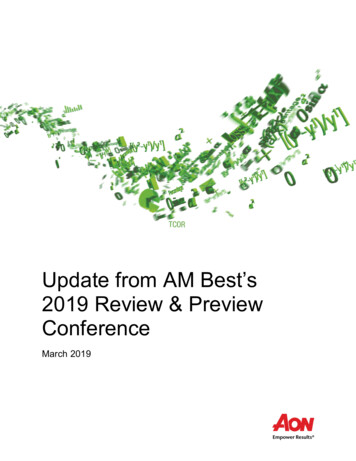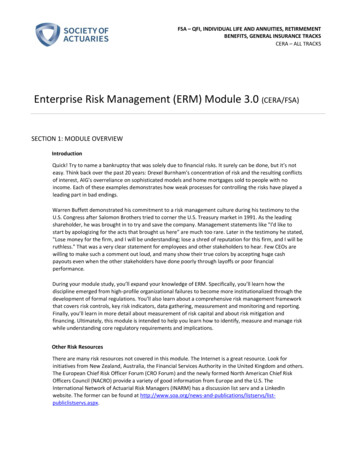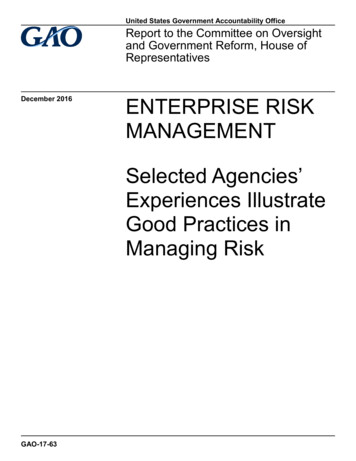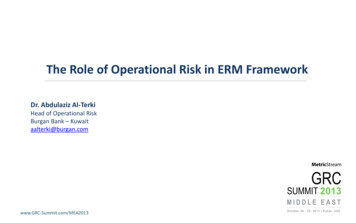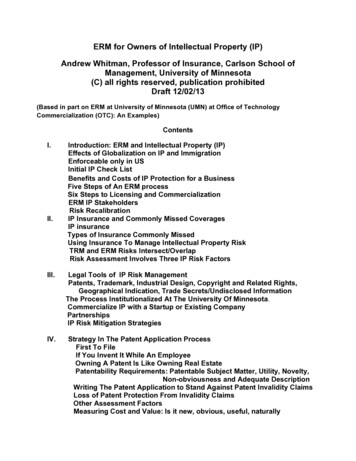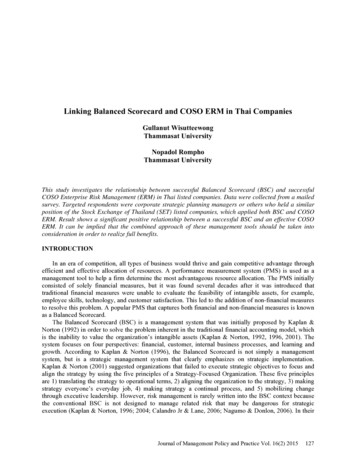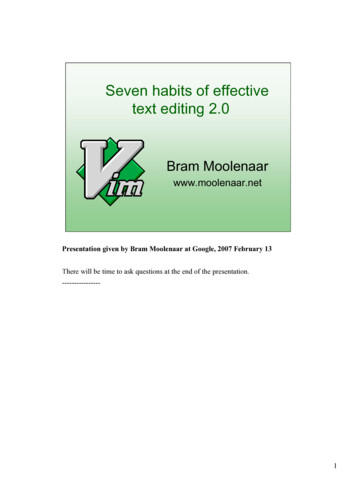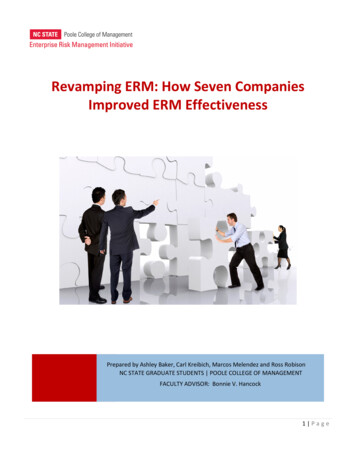
Transcription
Revamping ERM: How Seven CompaniesImproved ERM EffectivenessPrepared by: Michael Gore, Lucas Hyde, Na’thia Moses & JamesMerrittNC STATEGRADUATESTUDENTS,POOLEPrepared by AshleyBaker,Carl Kreibich,MarcosMelendez andRossCOLLEGERobison OFMANAGEMENTFACULTYADVISOR:BonnieV.HancockNC STATE GRADUATE STUDENTS POOLE COLLEGE OF MANAGEMENTFACULTY ADVISOR: Bonnie V. Hancock1 Page
ContentsIntroduction. 2Case Study and Participants. 2Linkage of ERM and Strategy . 3Improved Efficiency and Effectiveness . 5Broader Engagement. 6Better Dialogue and Decision Making . 7Conclusion . 10APPENDIX A . 11APPENDIX B . 19APPENDIX C . 25APPENDIX D . 29APPENDIX E. 33APPENDIX F. 37APPENDIX G . 41About the Authors. 461 Page
IntroductionEnterprise Risk Management (ERM) is an ongoing process that takes a holistic, portfolio approach to the mostsignificant risks to the achievement of the entity’s most important objectives. Most ERM processes start verysimplistically and evolve over time. As companies gain experience with ERM and identify best practices, they makeupdates and adjustments to the ERM process to improve its effectiveness.The main purpose of Revamping ERM: How Seven Companies Improved ERM Effectiveness case study is to documentand share examples of ERM process updates at seven different companies. The case study tracks how theparticipants across various industries and maturities of ERM functions have gone about modifying ERM practices.Additionally, the case study identifies similarities and differences between process improvements being completedacross the different companies. Critical success factors as well as potential challenges in implementation will benoted. The findings of this case study suggest that improvements to ERM processes are ongoing in nature. Each casestudy participant identified plans for future enhancements to their ERM process. Enhancements will continue to bemade as opportunities arise to streamline processes or enhance risk management effectiveness.The case study identified four main themes for ERM refresh activities among the seven participants. The mainthemes identified include linking ERM and strategy, improving efficiency, gaining broader engagement and betterdialogue leading to more informed decision making. One common finding throughout this case study was that theparticipants stressed the importance of executive support and endorsement. Executive support helps promotechanges and engagement across the organization in driving value from ERM. This case study aims to offer valuableinsight and useful information to anyone hoping to strengthen their ERM function as well as those who simply wantto learn more about the evolution of ERM processes.Case Study and ParticipantsThese case studies were conducted by first gaining an understanding of the overall ERM process at each company,and then understanding the most recent modifications that had been made to improve the effectiveness of theprocess. The understanding was accomplished by interviewing the ERM leadership at each company and asking whyeach improvement was made, including the objective for the change, what benefits were achieved and what thereactions were to the implementation.To ensure anonymity of the participants, we identified each company only by sector and revenue. Below is asummary of companies that are represented in this case study:ABCDEFGSectorOil and hnologiesBeverageOil and GasRevenue 2 Billion 10 Billion 22 Billion 51 Billion 36 Billion 97 Billion 11 BillionThe review of the seven different organizations reveals common themes around the evolution of ERM processes aswell as unique insights of best practices with each entity. Differences in industry, strategy, business model, culture,and maturity of ERM implementation are all contributing factors to the identified enhancements made to each ERMprocess.2 Page
Linkage of ERM and StrategyThe first common theme noted by case study participants surrounded the alignment of ERM and strategy processes.Entities will make better decisions and have a better chance of achieving strategic objectives if they appropriatelyconsider risk in developing and executing strategic plans. Five of the seven participants in the case study mentionedthey had engaged in ERM process updates that involved a better integration of ERM and strategy. The participantsaccomplished the linkage of ERM with strategy in a number of ways: by changing the focus of risks to include thoserelated to achieving strategy, by changing the organizational structure of the company and by aligning of the timingof key ERM processes with the strategy and objective setting process. Although the linkage of ERM and strategy is aworthwhile endeavor, some of the participants did face challenges in the integration process.By definition, ERM takes a holistic entity-wide approach to managing risk, and many studies have shown that thebiggest risks to a company are strategic in nature. Accordingly, four of the participants changed the focus of their riskidentification or risk assessment processes to specifically include risks to achieving company strategy. These fourcompanies acknowledged that their previous approach to risk management had been mostly compliance based innature. The companies realized that a more risk informed strategy would provide more value by proactivelyaddressing the potential risks that could threaten the success of strategic initiatives or damage their competitiveadvantage.Company A’s previous risk identification process was conducted by Internal Audit with a focus on internal controlsand finance related risks. In an effort to gain a better understanding of all entity wide risks, the Senior Managerresponsible for ERM conducts open ended interviews to identify risks that might be detrimental to strategy. Thequestions asked in the interview to identify strategic risks include: What do you see as Company A’s competitive advantage and do you see any risk to losing that advantage?What are the top three risks the company faces over the next five years that could have a significant adverseeffect on achieving the company’s strategic and/or financial objectives?What is the company doing to mitigate these risks?In your opinion, are these risk mitigation strategies effective? If not, what should we be doing?Risks identified from these interviews compose the risk universe for the company. The identification of risk with afocus on implications for the company’s strategy has given senior management a greater level of comfort thatstrategic goals will be met knowing that key risks have been identified and have a response plan in place.Similarly, Company B realized the need to integrate ERM and strategy following an incident where Internal Audit fellshort in their risk assessment by failing to discover that a competitor had developed a new technology thatthreatened the company’s competitive advantage. To ensure there are no gaps in the risk identification phase,interview questionnaires now ask respondents to identify and assess risks outside their scope as well as market orexternal risks to the company. Furthermore, as part of the risk response process, the Director of ERM includes amember of the strategy team when it meets with risk owners to walk through the top five risks in their businessoperation. The purpose of this discussion is to ensure that the identified risks have appropriate mitigation techniquesin place that are working effectively.Company F has taken a more strategic approach to Risk Management through the use of a longer-term horizon. Inthe past, the focus had been on more short-term, operational or compliance type risks that typically did not affectthe strategy or aid in long-term decision-making. Taking a more long-term view will allow the company to monitorand adjust to emerging risks, giving it more planning options to deal with risks as they arise. The longer time horizonallows for better integration with strategy, as there is a common focus on planning and dedicating resources toaddressing the disruptive risks the future may hold. This improvement has been accomplished mostly by (1)3 Page
developing a framework with an express focus on disruptive risk themes and (2) shifting the dialogues used in theannual interviews to stimulate more discussion about the long-term risks and opportunities that could disrupt theway the company does business.Company D changed its capital analysis decision making process to involve strategy and risk management staff. Thepurpose of the integration is to identify significant risks that underly proposed projects. Attention is devoted to themitigation of emerging and disruptive risks associated with each major project. The expansion of the risk profile hasallowed for a more informed decision-making process.Another common tactic used to integrate ERM with strategy has been through adjustment to the organizationalstructure of companies. Specifically, three of the participants made changes to their reporting or communicationlines to achieve better integration of ERM and strategy. Company B has aligned the reporting structure so that theERM function, led by the Director of ERM, now reports to the VP of Strategy in the organization. The VP of Strategy inturn reports to the CEO. Members of the strategy team frequently aid in ERM activities including interviews and riskassessments. This organizational structure allows for better collaboration and communication on critical strategic riskissues. Similarly, at Company F, the Director of ERM works closely with the Head of Strategy in an effort to be moreproactive and forward thinking about risk.At Company A, the Senior Manager leading ERM reports into the strategy organization, which is led by the VP ofStrategy. The VP of Strategy then in turn reports to the second highest ranking person in the company, the ExecutiveVP of Corporate Development. The company has made changes to its reporting lines to better address strategic risks.Previously, Company A had 3 groups reporting to the VP of Strategy: ERM (1 manager & analyst), Strategy (1manager & 2 analysts) and Project Management (1 consultant). The new organization structure that reports to the VPof Strategy has the three groups organized as follows: Strategy Planning & Development, Strategy Execution andStrategy Modeling & Analytics. The Senior Manager of Strategy Planning & Development identifies a risk and createsa scenario of how the risk might materialize. The Senior Manager of Strategy Modeling & Analytics takes thescenario and uses Monte Carlo analysis in a financial model to assess the range of possible impacts to the company.The team would then layer in mitigations to the risk identified. Finally, the Manager of Strategy Execution ensuresthat for implemented initiatives, activities that are key to achievement of objectives, including risk mitigations, are ontrack. The Manager of Strategy Planning & Development now acts more as an “ERM Program Leader”. The process ofestablishing an ERM program aligned with strategy was seen as necessary to expand ownership of risk managementthroughout their organization, instead of housing it in a single department.The last common process change made to better link ERM and strategy was the alignment of the timing of key riskmanagement functions with the timing of the strategy and objective setting process. Better alignment between thesetwo processes will ensure that key risk information is an input to the strategic planning process. Company A decidedthat the risk assessment process would be completed so that the information gathered could be an input in thedevelopment of strategic objectives at the company. The ERM function forecasts future trends that may impact thecompany and integrates those findings into the strategy. Following the risk assessment and forecasting process, thestrategic objectives of the company are developed and assigned to the appropriate department for execution.Additionally, Company E changed the timing of the assessment of strategic and operational risk from the first to thethird quarter in an effort to synchronize with the strategic planning cycle. The adjustment maximized the value of riskinformation for the strategy department by providing them with more timely and relevant information. Thealignment has supported the business growth strategy.All in all, companies reap the most benefit from their ERM functions when they are integrated with the strategy ofthe organization. The participants in the case study noticed some challenges to the process including changing themindset of employees to appreciate the value in ERM and deploy appropriate resources to risk management.However, the participants also noted that the most important element to seeing success within the ERM function isexecutive support. With the support of top executives and ongoing conversation and education around ERM,companies will likely observe noticeable benefits.4 Page
Improved Efficiency and EffectivenessMost ERM functions are thinly staffed; therefore it is essential to work efficiently if the function is going to be able toadd value to the organization. In addition, because ERM can sometimes be viewed as adding bureaucracy, the ERMfunction must leverage the work being done in other areas of the organization and carefully consider the demands itmakes of resources across the business. These factors have led companies to seek out and implement opportunitiesto make the ERM process more efficient.At Company C, the ERM department previously operated through the use of manual spreadsheets and status reports,which were useful but neither very effective nor efficient. Because of the manual effort involved in reporting, riskinformation tended to be shared only at a very high level. When the new CRO arrived, she was tasked withrefreshing the entire ERM process and quickly recognized that improving the quality of risk information would be themost important factor to reinvigorating the ERM process. Analyzing the data to provide better insights was one of thebiggest challenges they would face. The volume of data to be analyzed meant a manual approach would be too timeconsuming. The company chose to purchase a software system to automate the risk tracking and monitoring processin order to improve efficiency, but more importantly, provide more insightful and timely risk information. Thisresulted in more prompt action on critical issues and improved decision making overall.Companies G, A and B all made changes to their risk assessment and risk identification processes in an effort toimprove the effectiveness of the ERM process as a whole. The common goal of these organizations was to improvethe prioritization of risks and spend less time discussing the relative positioning of risks and more time developing aresponse to the most significant risks. In addition, the companies removed duplicate processes and ensured theoptimal number of participants and meetings were used to facilitate a meaningful discussion of risk.Company G changed the format of its quarterly workshops to reduce the participants in the workshop from 30-50 to10-15. In addition, the company found that having separate risk workshops for two separate legal entities wasredundant. In order to reduce this, they combined their two separate quarterly meetings into one. The conversationin the workshops has changed from refining risk reports to discussing opportunities to integrate risk into decisionmaking and existing processes. Additional topics that are now covered in the workshops include emerging risks,management system gaps, and topics to present to the Board. These changes will make better use of executives’time and should generate greater insights regarding the company’s most pressing risks.Company A has simplified their risk assessment process in order to better categorize risks. While the organizationwas preparing a top 10 list and creating heat map visualizations, it was not bridging the gap from risk assessment torisk response. The process change involved first changing the assessment process and then creating grouping basedupon the desired risk response. The company changed the assessment process from a 5-point rating scale to a 4point rating scale (1-minimal 2-major 3-critical 4-catastrophic) across 5 dimensions (environment, health &safety,reputation, legal & compliance, financial & strategic). A 4-point scale was found to be more effective because it hasno “middle” and therefore, forces respondents to pick a side. The ERM function strayed away from a forced rankingtechnique because the fear was that it could lead to arguments and debate over the positioning of risks, rather thanthe actions around better management of the risks. The improvement to risk assessment was necessary tostreamline risks and ensure that the proper policies and procedures were in place to direct attention and resourcesto emerging risks.The company has benefited from the strengthening of the risk assessment process by being able to better link theidentification phase to the response. Moving forward, the company will continue to benefit from this improvementby being better equipped to choose the appropriate response mechanism. The risk response matrix adopted by thecompany places risks into 4 categories of “prepare, act, park and adapt” based on the risk results related to impactand likelihood. The matrix has provided the organization with the appropriate nomenclature to better engage in risk5 Page
dialogue. The improvement will be most noticeable in the integration of risk with strategy as the company is betterable to understand the nature and exposure of their risks.At Company B, changes were made to the risk identification and assessment process as a result of the integration ofERM and strategy. The Director of ERM initiated the change because he believed the two-dimensional heatmap andscoring system in which risks were ranked on a 3-point scale did not sufficiently differentiate the risks. Now, riskidentification and assessment are initiated through the use of open-ended interviews that ask respondents fromdifferent regions to list the top three to five risks in their area of focus. After risks have been identified, each risk isranked on a 5-point scale that goes from minimal to catastrophic across 5 dimensions of the company very similar tothose used by Company A above. The objective of the change was to help people better differentiate and prioritizerisks as well as allocate resources within the organization more efficiently. Better prioritization of risks has made ERMmore relevant and allowed stakeholders to see the value in the process.Company E found opportunities to gain efficiencies by forming a tighter relationship between the ERM function andInternal Audit through the creation of a strategy board. The strategy board is composed of representatives from boththe risk and the Internal Audit functions. This board has quarterly meetings to consolidate the information providedby both departments and provides a forum to discuss risk mitigation activities. These discussion topics may becandidates for Internal Audit to include in the scope of their audit plan or to provide additional details that arehelpful in existing audit activities. The sharing of risk identification and assessment information, as well as riskmitigation plans at a more granular or “auditable” level, helps the two organizations coordinate their work to ensurerisk responses are working as intended. It also increases the accountability of risk owners in both the ERM functionand Internal Audit.Whether through automation, simplification or leveraging of existing resources, each of these participantsmentioned have implemented process improvements that allow for a better use of limited resources. All thecompanies emphasized that their processes were still a “work in progress” and that they would continue to look forways to streamline work and structure their processes to improve the focus on those risk management activities thatprovide the greatest value.Broader EngagementAn important aspect of a successful ERM environment is the broad engagement in the risk management activitiesthroughout the organization. In order to make risk management more relevant throughout an organization, allemployees in decision-making positions should know how risks and risk management processes affect theorganization as a whole as well as their individual area of responsibility. If an employee does not see how the ERMprocess can offer valuable input into their individual area of responsibility, then that created value may be lost intranslation. Therefore, it is paramount to establish broad engagement throughout the organization.The participants of this case study took different approaches to achieve broader engagement throughout theirorganizations. Company D implemented a bottom-up approach to risk identification while Company F focused on theimplementation of ERM processes and establishing their importance at the local level. Company C expanded theareas within the company that fall within the scope of the Risk Council to promote better engagement across abroader group of employees.An important starting point in engaging more employees in the risk management process is to ensure that theemployees understand that the ERM process is value adding at all levels within the organization At Company F, therewas a lack of understanding by employees in local operating units of how the ERM process could add value to theirdaily work. This issue was tackled by showing employees how ERM could make their jobs easier and how it couldallow them to use their time more productively. Similarly, Company C also focused on communicating the value of6 Page
ERM throughout the entire organization. The approach they took involved increasing engagement with the projectmanagement function in order to integrate risk considerations into major projects that affect one or more businessunits across the company. As a result of those efforts, more business units have come forth and asked for assistancefrom the ERM department.Broader engagement with ERM can improve the effectiveness at all stages of the process. As Company Dimplemented a bottom-up risk approach to their risk identification process, it allowed them to see similarities anddifferences between the top and lower levels of the organization The combination of the already existing top-downapproach with the newly implemented bottom-up approach enabled the company to assess the potential impact ofrisks more precisely across the entire organization, thus improving the accuracy of the assessment. Increasedengagement of the lower levels of the company in the ERM process has helped them apply a more holistic and entitywide approach to risk management.Another company found that in order to engage more employees in the risk management process, the informationthe ERM department provides needs to be more granular and tailored to each department. If the ERM departmentfails to provide thorough and detailed information, personnel within the lower levels of the organization may notunderstand how the information is useful or beneficial to them. Company F moved to a new cloud-based system toprovide the risk owners with more customized granular information using dashboards and visualizations. Thisinformation can be shared at the local level to help the employees understand how risks can impact theirorganization. Similarly, at Company B, the risk department tailors its risk reports to the specific user to help themunderstand the value and application of ERM to their area of responsibility.The participants of this case study used a multitude of techniques to broaden ERM engagement throughout theorganization. Company D used surveys of business process owners in order to support their bottom-up approach inthe risk identification process. Company C, on the other hand, communicated tangible examples to demonstrate thatERM adds value for risk owners. Additionally, Company F used the implementation of a new software to show howthe ERM process is valuable in every part of the company, subsequently convincing employees that the ERM processcan benefit them in their individual areas of responsibility. The fact that these companies took different approachesto improve engagement across the organization reflects the importance of customizing the ERM process to fit eachindividual organization.The main challenge to gaining broader engagement in the ERM process is convincing Senior Management as well asrisk owners that it is worth the time to focus efforts on getting more employees engaged and invested in the ERMprocess. Moreover, it is important for corporate leaders to understand that the risk management process is not justdone by the ERM department itself, but by everyone across the entire entity. All employees face risks on a daily basisand are a valuable source of risk information for the first line of defense in responding to risks. Engaging moreemployees often requires additional resources to be devoted to risk management, but there can be significantrewards in terms of better performance. The ERM team must make the case for the return on investments in ERM.Better Dialogue and Decision MakingA key component to any successful ERM program is open and effective communication. The ERM function needs tocommunicate the right risks to the right people at the right time. Ideally communication within the organizationshould have a continual flow between employees, management, senior management and the Board of Directors.Communication is vital to establish relationships built on trust between the ERM department, business units andfunctions across the organization. Without focused dialogue on risks, entities could fall behind their competitors andpotentially lose their competitive advantage. The participants in this case study have focused on involving the rightpeople and facilitating the right environment that creates a better platform to make more informed decisions.7 Page
Company G has made changes to the format of Executive Workshops which are conducted quarterly and facilitatedby the Director of Capital Analysis & Insurance. Previously, there were 30-50 invitees including executive levelmanagement. Now, the number of individuals participating in the quarterly Executive Workshop has been reduced to10 members. These members consist of core ERM Committee members (President and CFO of each businesssegment), General Counsel, and the Chief Compliance Officer. Having a smaller group participate in the meetings hasfacilitated more meaningful dialogue by shifting the discussion from ‘risk list management’ and ‘wordsmithing’ riskupdates to discussion of opportunities to integrate risk into decision-making and existing processes.With the change to make executive workshops more exclusive, however, came the unintended consequence oflosing the presence of Subject Matter Experts (SMEs) previously in attendance. This led to Company G’s second majorimprovement, which was establishing a Risk Community for business units and risk managers to share best practicesand improve risk management systems to support risk-based decision-making. The risk community will meetquarterly with all SMEs and Risk Owners to discuss opportunities for improvement in the current risk process, identifyemerging risks and opportunities that may impact the company’s strategic objectives, and more fully integrate riskmanagement into existing decision-making processes. Company G is still in the planning process of launching the‘Risk Community’ in the coming m
consider risk in developing and executing strategic plans. Five of the seven participants in the case study mentioned they had engaged in ERM process updates that involved a better integration of ERM and strategy. The participants accomplished the linkage of ERM with strategy in a number of ways: by changing the focus of risks to include those

